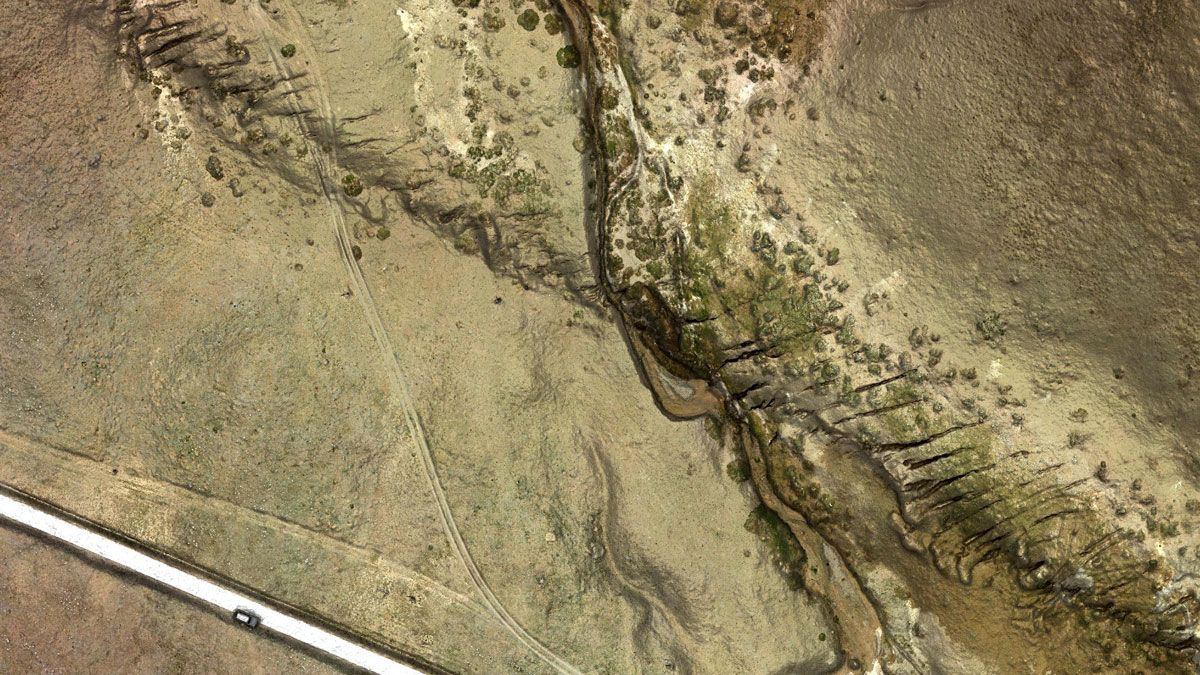Close examination of a 2021 earthquake on the Tibetan Plateau provides hints that, counter to prior assumptions, the influence of fault orientation can sometimes trump that of maturity.
Researchers used unmanned aerial vehicle images superimposed on centimeter-resolution topography to study the surface rupture of the 2021 magnitude 7.4 Maduo earthquake in China. This image shows the fault scarp, tensional cracks on the hanging wall, and the left-laterally offset channel. Credit: Yanxiu Shao
Source: AGU Advances

In the early morning of 22 May 2021, a magnitude 7.4 quake rattled China’s remote Maduo County on the Tibetan Plateau. It was the most recent in a series of nine earthquakes with a magnitude of 7 or greater since 1997, and its surface rupture was twice as long as the global average for similarly sized quakes. The tremor occurred on the eastern part of the relatively immature left-lateral Jiangcuo fault system, which slips slowly, about 1 millimeter per year, and was unmapped before the quake.
Uncovering the geological dynamics of this disaster could help inform future efforts to assess seismic hazards in the region and around the world. In a new report, Liu-Zeng et al. analyze the Maduo quake to probe the relationship between fault structure and earthquake dynamics.
To do so, the researchers combined field observations with satellite images taken prequake and postquake as well as with centimeter-resolution photos taken of the fault system by an unmanned aerial vehicle. These remote sensing techniques enabled them to analyze fractures that would otherwise be inaccessible because of their high altitude and harsh surrounding environment.
The research team assessed changes to Earth’s surface both on and near the fault segments involved in the quake. The segments had varying orientations with respect to the overall regional patterns of seismic stress, as well as varying degrees of maturity. Maturity is not necessarily synonymous with age; rather, it indicates the degree of a segment’s development, or how much it has changed with time and activity.
Prior research has highlighted the importance of fault maturity in earthquake dynamics. However, in the case of the Maduo quake, the researchers found that the faults’ orientations played a larger role in the magnitude and the degree of localization of surface deformation than their maturity levels. These findings suggest that future seismic hazard assessments might be enhanced by more thoroughly accounting for fault segment orientation in the context of regional stress conditions. (AGU Advances, https://doi.org/10.1029/2023AV001134, 2024)
—Sarah Stanley, Science Writer
Citation: Stanley, S. (2024), Fault maturity or orientation: Which matters more for quakes?, Eos, 105, https://doi.org/10.1029/2024EO240141. Published on 10 April 2024.
Text © 2024. AGU. CC BY-NC-ND 3.0
Except where otherwise noted, images are subject to copyright. Any reuse without express permission from the copyright owner is prohibited.
Source link: https://eos.org/research-spotlights/fault-maturity-or-orientation-which-matters-more-for-quakes






